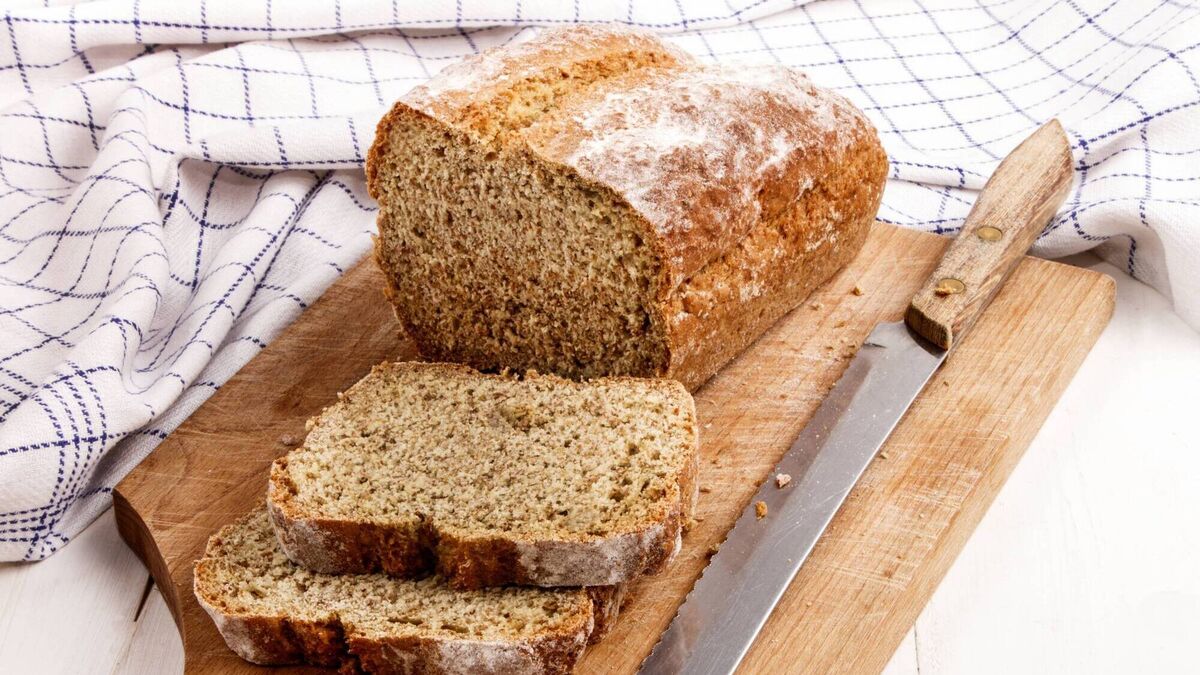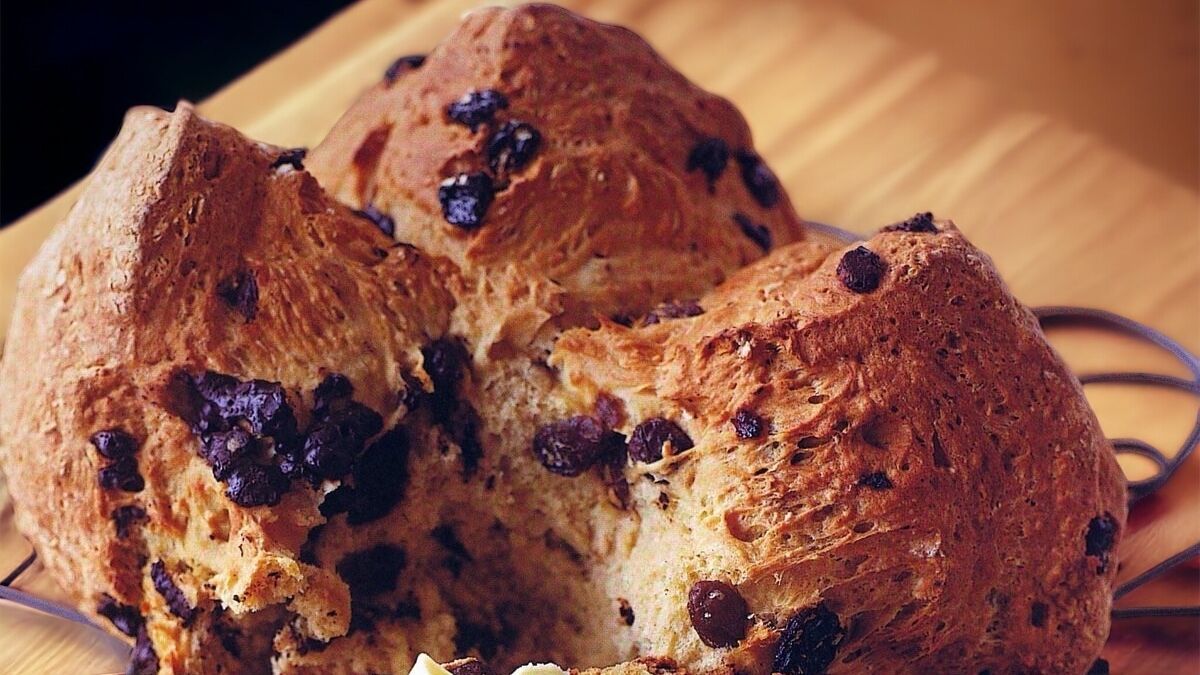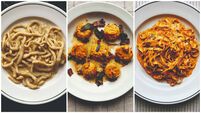Darina Allen: How to make the perfect soda bread, and other traditional Irish recipes
Darina Allen with her spotted dog and Irish soda bread for St. Patrick's day at Ballymaloe cookery school. Picture; Eddie O'Hare
We all have a few special Saint Patrick’s Day dishes that we rustle up to serve to family and friends gathered around the kitchen table.
I just love bacon and cabbage and parsley sauce. Of course, corned beef and cabbage is the emigrant’s favourite in America and very tasty it is too with some real Colman's mustard mixed from the powder.
Many local butchers still make a batch of corned beef for Saint Patrick’s Day. We serve it at the Cookery School to our multi-ethnic students, but it has to be said that for many of our Irish students, it’s their very first taste of corned beef and they love it. Cook it with lots of chunky carrots and quartered cabbages and a big jug of parsley sauce - and don’t forget plenty of floury potatoes and butter.
We also love to make a couple of spotted dogs to serve freshly baked and still warm slathered with butter for tea - totally irresistible. Remember, I’m on a mission to get everyone making some bread. Soda bread is the quickest and easiest and spotted dog, speckled with dried fruit, is just a variation on the white soda bread.
This recipe is from ‘The New Ballymaloe Bread Book’ published by Gill Books just before Christmas and I have to say it has been responsible for taking the mystery out of bread making for so many people which is definitely the object of the exercise. Now that the squishy commercial bread and faux sourdough have become so ubiquitous and seem to be unquestionably linked to the phenomenal rise in intolerances, it’s time to turn on the oven.
Our field rhubarb is growing apace. For me, there has to be a rhubarb tart or rhubarb pie on Saint Patrick’s Day with lots of custard and a big dollop of whipped cream for a real celebration.
Happy Saint Patrick’s Day.
Darina Allen's soda bread
A traditional Irish soda bread.

Servings
4Preparation Time
15 minsCooking Time
35 minsTotal Time
50 minsCourse
BakingCuisine
IrishIngredients
340g wholemeal flour
110g plain white flour
15g butter
A barely rounded teaspoon of bread soda
1 tsp salt
1 egg
415ml (470ml, minus the egg) buttermilk
Method
Preheat the oven to 230ºC.
Mix the flours in a large bowl and rub in the butter. Add the salt and sieved bread soda. Lift the flour up with your fingers to distribute the salt and bread soda.
Add the beaten egg (if using) to the buttermilk. Make a well in the centre and pour in all the liquid. With your fingers stiff and outstretched, stir in a circular movement from the centre to the outside of the bowl in ever-increasing concentric circles. When you reach the outside of the bowl seconds later the dough should be made.
Sprinkle a little wholemeal flour on to the worktop. Turn the dough out onto the flour. Sprinkle a little flour on your hands. Gently tidy the dough around the edges and flip onto the flour. Tuck the edges underneath with the inner edge of your hands, gently pat the dough with your fingers into a loaf about 4cm thick.
Cut a deep cross into the bread (this is called ‘Blessing the bread’ and then prick it in the centre of the four sections to 'let the fairies out of the bread').
Transfer to a floured baking tray.
Bake in the preheated oven for 5 minutes and then reduce the temperature to 200ºC for the remaining 25-30 minutes. Turn the bread upside down after approximately 30 minutes. Cool on a wire rack.
Spotted Dog (a variation on white soda bread)
Taken from ‘The New Ballymaloe Bread Book’ by Darina Allen, published by Gill Books.

Servings
4Preparation Time
15 minsCooking Time
40 minsTotal Time
55 minsCourse
BakingCuisine
IrishIngredients
450g plain flour, preferably unbleached
1 level teaspoon bicarbonate of soda
110g plump sultanas
1 dessertspoon sugar
1 level teaspoon salt
1 egg
350ml buttermilk (approx.)
Method
Preheat your oven to 220°C/Gas Mark 7.
Sieve the flour and bicarb into a large mixing bowl, then add the fruit, sugar and salt. Mix the ingredients well by lifting them up above the bowl and letting them fall loosely back into the bowl through your fingers. This adds more air and therefore more lightness to the finished bread.
Now make a well in the centre of the flour. Break the egg into the bottom of the measuring jug, whisking to break it up, then add the buttermilk up to the 400ml level, so that the egg makes up part of the total liquid measurement. Pour most of this milk and egg mixture into the flour.
With your fingers open and stiff, mix in a full circular movement, drawing in the flour from the sides of the bowl. Add more milk and egg mixture if necessary.
The dough should be nice and soft, but not too wet and sticky.
With spotted dog, as with all soda breads, mix as quickly and as gently as possible to keep the dough light and airy but avoid over-mixing. When it comes together - a matter of seconds - turn it out onto a well-floured work surface. Wash and dry your hands.
With floured hands, roll the dough lightly for a few seconds, just enough to tidy it up. Pat the dough into a round and press gently with the fingers to about 6cm high.
Transfer the dough onto a baking tray dusted lightly with flour. Mark the top with a deep cross and prick each of the dough triangles with your knife to let the pesky fairies out.
Bake in the preheated oven for 5 minutes, then reduce the temperature to 180°C/Gas Mark 4 and bake for a further 35 minutes, until the bottom sounds hollow when tapped.
Traditional Irish Bacon, Cabbage and Parsley Sauce
Is there anything more quintessentially Irish than bacon and cabbage?

Servings
10Preparation Time
10 minsCooking Time
2 hours 0 minsTotal Time
2 hours 10 minsCourse
MainCuisine
IrishIngredients
About 2.25kg (5lb) loin, collar or streaky bacon, either smoked or unsmoked with the rind on and a nice covering of fat
1 Savoy or 2 spring cabbages
50g (2oz) butter
Freshly ground pepper
For the parsley sauce:
600ml (1 pint) full-cream milk
A few parsley stalks
Sprig of thyme
A few slices of carrot (optional)
A few slices of onion (optional)
Salt and freshly ground pepper
50g (2oz) roux (50g of melted butter mixed with 50g of plain flour)
About 50g (2oz) curly parsley, freshly chopped
Method
Cover the bacon in cold water in a large pot and bring slowly to the boil. If the bacon is very salty there will be a white froth on top of the water, in which case it is preferable to discard the water and start again.
Cover with hot water and the lid of the pot and simmer until almost cooked, allowing 20 minutes for every 2.2kg (1lb).
Meanwhile, trim the outer leaves of the cabbage and cut it into quarters, removing the core. Discard the core and outer leaves. Slice the cabbage across the grain into thin shreds.
If necessary, wash it quickly in cold water. About 20 minutes before the end of cooking the bacon, add the shredded cabbage to the water in which the bacon is boiling.
Stir, cover and continue to boil gently until both the cabbage and bacon are cooked — about 1¾ hours.
Lift the bacon onto a plate and remove the rind if you like. When the bacon is fully cooked it will peel off easily.
Strain the cabbage and discard the water (or, if it’s not too salty, save it for soup).
Add a generous lump of butter to the cabbage. Season with lots of ground pepper; it’s unlikely to need more salt, but add some if necessary.
You can make the parsley sauce while the bacon is cooking. Put the cold milk into a saucepan and add the herbs and vegetables (if using). Bring the mixture to simmering point, season and simmer for 4–5 minutes. Strain the milk, bring it back to the boil and whisk in the roux until the sauce is a light coating consistency. Season again with salt and freshly ground pepper. Add the chopped parsley and simmer on a very low heat for 4–5 minutes. Taste and correct the seasoning.
Rhubarb and Custard Tart with Pistachios
Rhubarb and custard are a combo made in heaven.

Servings
10Preparation Time
1 hours 40 minsCooking Time
59 minsTotal Time
2 hours 39 minsCourse
BakingIngredients
Pastry
225g plain flour
pinch of salt
175g soft butter
1 dessertspoon icing sugar
a little beaten egg or egg yolk and water to bind
Filling
600g or a little more rhubarb, cut into small pieces
1-2 tablespoons caster sugar
2 large or 3 small eggs
3 tablespoons caster sugar
1 teaspoon pure vanilla extract
300ml cream
Garnish
45g coarsely chopped pistachio nuts (optional)
To Serve
softly whipped cream
1 x 30.5cm tart tin or 2 x 18cm tart tins
Method
Make the shortcrust pastry.
Sift the flour and salt into a large bowl. Cut the butter into cubes, toss in the flour and then rub in with your fingertips.
Keep everything as cool as possible; if the fat is allowed to melt, the finished pastry may be tough. When the mixture looks like coarse breadcrumbs, stop. Add the icing sugar.
Whisk the egg or egg yolk and add some water. Using a fork to stir, add just enough liquid to bring the pastry together, then discard the fork and collect it into a ball with your hands, this way you can judge more accurately if you need a few more drops of liquid. Although rather damp pastry is easier to handle and roll out, the resulting crust can be tough and may well shrink out of shape as the water evaporates in the oven. The drier and more difficult-to-handle pastry will give a crisper, shorter crust.
Wrap in parchment paper and leave to relax in the fridge for at least 1 hour before using. It will keep for a week in the fridge and also freezes well.
Line a tart tin (or tins), with a removable base and chill for 10 minutes. Line with paper and fill with dried beans and bake blind in a moderate oven 180°C/Gas Mark 4 for 15-20 minutes. Remove the paper and beans, paint the tart with a little egg wash and return to the oven for 3 or 4 minutes.
Arrange the cut rhubarb evenly or in a chevron pattern on the base of the tart shell. Sprinkle with 1-2 tablespoons caster sugar.
Whisk the eggs well, with the 3 tablespoons sugar and vanilla extract, add the cream. Strain this mixture over the rhubarb and cook in the preheated oven for 35 minutes until the custard is set and the rhubarb is fully cooked.
Scatter with coarsely chopped pistachios. Serve warm with a bowl of softly whipped cream.
Order 2.2kg of topside, brisket, “housekeeper’s cut” or silverside from your butcher. The latter is leanest and most expensive in my opinion
It’ll be easier to cut the beef into perfect slices if you tie the beef into a neat shape with three pieces of white cotton string (this is optional).
Put the chosen cut of beef in the brine and sprinkle the top with another 110g salt. Put a cold sterilised plate on top of the beef and a weight on top of the plate so that none of the meat is exposed to the air (we use a Pyrex measure filled with water). Leave the meat in the brine for five days; after that, cook and serve as desired (see instructions below). ( The used brine makes a great weed-killer for gravel paths.)
Corned beef is available at Frank Murphy Butchers in Midleton and Tom Durcan Meat’s in The English Market









